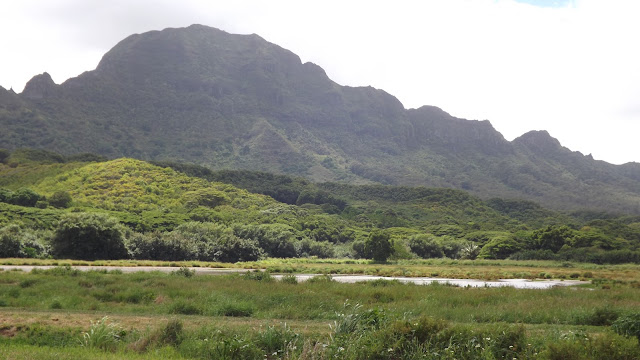REFUGE WEEK
OCTOBER 2013
HULE'IA REFUGE
(hoo-lay-ee-ya)
Lots of events happen each October
since it is refuge week nationally. Kauai is lucky to have three separate sites that belong
to the refuge system. Kilauea Point, of
course, usually referred to as the Lighthouse, is open to the public. Sunday, the first day of the week, admittance
was free. Hanalei is not open to the
public however, it is one of the most photographed locations on the island
because of the overlook near Foodland.
The patchwork quilt of taro patches is perhaps as famous as the
Lighthouse for its scenic appeal.
Hule'ia Refuge is neither open to the
public nor visible for viewing from above.
Well, that is not entirely true. There is an overlook for the Menehune
Fishpond and the refuge is just upriver – all you see is
green-green-green.
Menehune Fishpond (true name is 'Alekoko Fishpond) along Hule'ia River
The land area past the fishpond, jutting into the river is the refuge
The only way to really see the refuge is by tour during Refuge
Week. Just like Hanalei, the endemic
birds use the wetlands to live and nest:
Hawaiian Stilts, Hawaiian Coots, Hawaiian Moorhens, Koloa Ducks, and the
Nene.
Looking toward the mouth of the Hule'ia River which follows this mountain range
Looking toward river obscured by mangroves and larger trees,
the wetlands have been laboriously cleared of foliage
Looking upriver
I had not been to the refuge for several years and it was great to see
the progress. Of course, funds are even
worse now for National Wildlife Refuges and there is one worker and one small
machine to clear the wetlands and keep them clear.
Buffalo grass
The entire refuge would return to looking like this rapdily -
not a native plant in site,just agressive invasives
Mike Mitchell is the ranger in
charge of both Hanalei and Huliea wetland refuges and he knows the needs of the
birds. During non-nesting seasons the
nutritional diets vary from the nesting stage.
Females require different nutrients when forming the egg, once the egg
is laid to replenish herself; and then specific plants/bugs are needed by young
chicks to support their growth. The
different birds have different nesting preferences – the gallinule likes to
hide in the plants along the edge while the coots make floating nests among
plants in the water. The ideal wetland vegetation is a mixture of natives and “bird friendly” non-invasive, non-natives
that serve the winged community.
Mike is very fond of the millet he is showing here
The Nene have made a significant
comeback since their near extinction in the 1950s-60s. Down to 30 birds then, there are now about
2500 between all the islands. Recently
however, they were nesting too near the Lihue Airport Maui ?). The hope is that the young birds will not
return to the vicinity of the airport and that the parents will not nest there
again. A five mile bird-free radius is deemed
safe for all concerned.
Kauai Lagoons
earlier this year – before removal.
Hule'ia Refuge is outside the
five mile radius of the airport. In an effort to
attract Nene to that safe location, decoys have been set up. We were all fooled by them from a distance –
because they move! Even right up next to
them, they are good replicas.
Our friend Jen Hahn (see botulism post) painted them and has moved on from Americorps and general volunteering to the task of monitoring the golf course for Nene.









sharon & gil
ReplyDeletebeautiful pictures of the canyons...i didn't realize the islands had such beautiful places. thanks to you two i am getting an education on the islands as i'm sure i will never get there to see them in person. excellent job guys! love jody